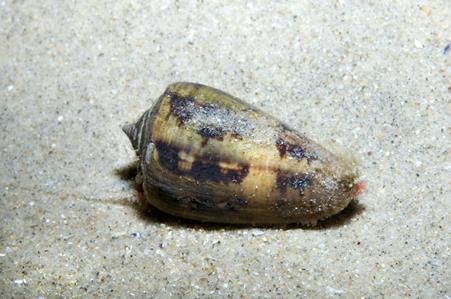Other Names
- Anemone Cone
General Description
Shell elongated conical shape with a short pointed end (spire). Covered by a thin yellow-brown skin (periostracum), white-cream with orange and dark brown markings underneath. Opening extends along the side of the shell. Shell up to 5 cm long.
Biology
These snails spear their prey with hard calcium darts armed with paralysing toxins. The toxin causes painful wounds, fainting and semi-paralysis in humans - tropical species have caused fatalities. They are one of only a few cone shell species that live in Victorian waters.
Habitat
Exposed and sheltered waters.
Reefs
Coastal shores
Distribution guide
Southern Australia.
Species Group
Sea snails and shells › Snails
Depth
Shore (0-1 m)
Shallow (1-30 m)
Water Column
Max Size
5 cm
Diet
Carnivore
Harmful
Toxic darts dangerous to humans.
Commercial Species
No
Global Dispersal
Native to Australia
Species Code
MoV 1733
Conservation Status
- DSE Advisory List : Not listed
- EPBC Act 1999 : Not listed
- IUCN Red List : Not listed




